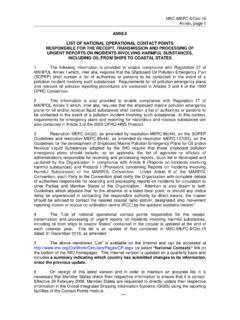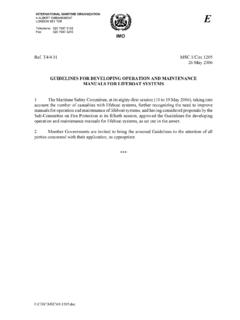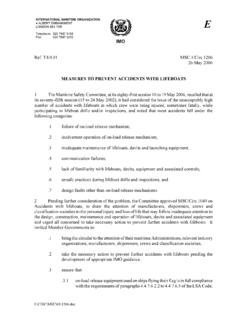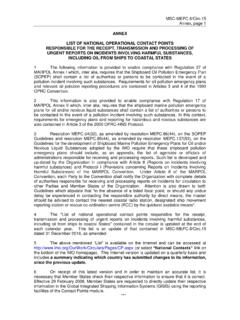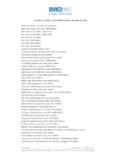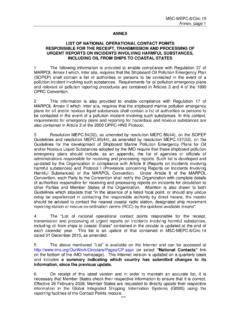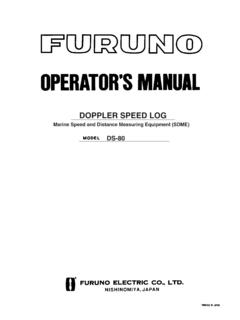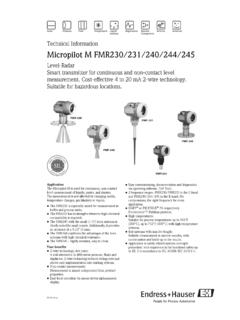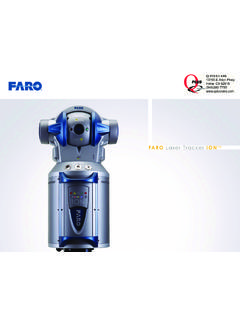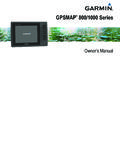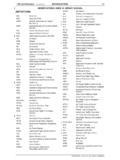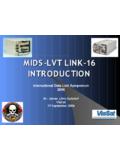Transcription of INTERNATIONAL REGULATIONS FOR HIGH-SPEED CRAFT …
1 InternationalConference on Fast Sea Transportation FAST 2005, June 2005, , Russia INTERNATIONAL REGULATIONS FOR HIGH-SPEED CRAFT AN OVERVIEW* Heike Hoppe INTERNATIONAL Maritime Organization (IMO) 4 Albert Embankment, London SE1 7SR, United Kingdom ABSTRACT The paper presents an overview of the INTERNATIONAL REGULATIONS in force concerning HIGH-SPEED CRAFT , the Code of Safety for Dynamically Supported CRAFT (DSC Code) and the INTERNATIONAL Codes of Safety for HIGH-SPEED CRAFT 1994 and 2000. The historical background of the development of REGULATIONS for HIGH-SPEED CRAFT is briefly highlighted and the technical contents of the Codes are described. The status of the Codes, mandatory or recommendatory, is explained, together with their association with the INTERNATIONAL Convention for the Safety of Life at Sea (SOLAS) 1974. Finally, on-going work in IMO regarding the review of the Codes and the preparation of appropriate amendments is outlined.
2 * Views expressed in this paper are those of the author and should not be construed as necessarily reflecting the views of IMO or its Secretariat. INTRODUCTION The INTERNATIONAL conventions ratified in respect of conventional ships and the REGULATIONS applied as a consequence of such conventions have largely been developed with construction and operation aspects in mind. Traditionally, ships have been made of steel and have been expected to operate on a world-wide basis with a minimum of operational controls. The requirements for ships engaged on long INTERNATIONAL voyages are therefore framed in such a way that, providing the ship is presented for survey and a Ship Safety Certificate is issued, the ship may go anywhere in the world without any operational restrictions being imposed.
3 Providing the ship is not involved in a casualty, all that is needed is to make it available to the Administration for the purpose of a satisfactory renewal survey before the Ship Safety Certificate expires and the Certificate will be reissued. However, the traditional method of regulating ships should not be accepted as being the only possible way of providing an appropriate level of safety. Nor should it be assumed that another approach, using different criteria, could not be applied. Over a long period of time, numerous new designs of marine vehicles have been developed and have been in service. While these do not fully comply with the provisions of the INTERNATIONAL conventions relating to conventional ships built of steel, they have demonstrated an ability to operate at an equivalent level of safety when engaged on restricted voyages under restricted operational weather conditions and with approved maintenance and supervision schedules.
4 1. HISTORICAL DEVELOPMENT OF HIGH-SPEED CRAFT REGULATIONS General The safety philosophy of the REGULATIONS for HIGH-SPEED CRAFT (HSC) is based on the management and reduction of risk as well as the traditional philosophy of passive protection in the event of an accident. Management of risk through accommodation arrangements, active safety systems, restricted operation, quality management and human factor engineering should be considered in evaluating safety equivalent to current conventions. The application of mathematical analysis to assess risk and determine the validity of safety measures is encouraged. The REGULATIONS take into account that a HIGH-SPEED CRAFT is of a light displacement compared with a conventional ship. This displacement aspect is the essential parameter to obtain fast and competitive sea transportation and consequently the REGULATIONS allow for use of non-conventional shipbuilding materials, provided that a safety standard at least equivalent to conventional ships is achieved.
5 To clearly distinguish such CRAFT , criteria based on speed and volumetric Froude number have been used to delineate those CRAFT to which these REGULATIONS apply from other, more conventional, CRAFT . Code of Safety for Dynamically Supported CRAFT (DSC Code) The DSC Code was adopted by the IMO Assembly on 14 November 1977 by resolution (X), recognizing that the design criteria for dynamically supported CRAFT are often quite different from those of conventional ships, making the application of INTERNATIONAL conventions such as the SOLAS Convention inappropriate in respect to those types of ships. The provisions of the Code superseded a number of earlier IMO recommendations concerning hydrofoil boats and air-cushion vehicles. The Code applies to CRAFT engaged in INTERNATIONAL voyages constructed before 1 January 1996 and sets out minimum requirements for CRAFT carrying up to a maximum of 450 passengers and operating within a distance of 100 nautical miles from a place of refuge.
6 INTERNATIONAL Code of Safety for HIGH-SPEED CRAFT (HSC Code) 1994 The 1994 HSC Code was adopted by IMO s Maritime Safety Committee (MSC) on 20 May 1994 by resolution (63), recognizing the continual development of novel types and sizes of HSC which were not necessarily dynamically supported, including cargo CRAFT and passenger CRAFT carrying larger number of passengers or operating at greater distances from places of refuge than permitted by the DSC Code. It was further recognized that improvements in maritime safety standards since the adoption of the DSC Code needed to be reflected in the provisions for HSC in order to maintain certification and safety equivalence with conventional ships. The Code applies to HSC engaged in INTERNATIONAL voyages and constructed on or after 1 January 1996 but before 1 July 2002.
7 It introduces two differing principles of protection and rescue. The first is the concept of assisted CRAFT , forming the basis for category A passenger CRAFT , permitting a reduction in active and passive protection where rescue assistance is readily available and the total number of passengers is limited. The second concept recognizes the further development of HSC into larger CRAFT and introduces unassisted CRAFT , forming the basis for cargo CRAFT and category B passenger CRAFT , requiring additional passive and active safety precautions where rescue assistance is not readily available and/or the number of passengers is unlimited. INTERNATIONAL Code of Safety for HIGH-SPEED CRAFT (HSC Code) 2000 The 2000 HSC Code was adopted by IMO s MSC on 5 December 2000 by resolution (73), recognizing the development of novel types and sizes of HSC and improvements of maritime safety standards since the adoption of the 1994 HSC Code which necessitated the revision of the provisions for the design, construction, equipment and operation of HSC in order to maintain the highest level of safety.
8 The Code applies to HSC engaged in INTERNATIONAL voyages and constructed on or after 1 July 2002 with a view to ensuring that safety is not compromised as a result of continuous introduction of state-of-the-art technology and innovative developments into the new and generally much larger and faster HSC. Status of the Codes The DSC Code as an IMO Assembly resolution is of a recommendatory nature, not a mandatory IMO instrument. IMO Member Governments are invited to take appropriate steps to give effect to the Code. The 1994 HSC Code was made mandatory by Resolution 1 of the 1994 SOLAS Conference, adopted on 24 May 1994, which entered into force on 1 January 1996 and included a new chapter X on Safety measures for HIGH-SPEED CRAFT in the 1974 SOLAS Convention. Regulation 1 of chapter X states: 1 HIGH-SPEED CRAFT Code, 1994 (1994 HSC Code) means the INTERNATIONAL Code of Safety for HIGH-SPEED CRAFT adopted by the Maritime Safety Committee of the Organization by resolution (63), as may be amended by the Organization, provided that such amendments are adopted, brought into force and take effect in accordance with the provisions of article VIII of the present Convention concerning the amendment procedures applicable to the annex other than chapter I.
9 The 2000 HSC Code was made mandatory by resolution (73), adopted on 5 December 2000, which entered into force on 1 July 2002 and amended SOLAS chapter X by, inter-alia, including the following new paragraph in regulation 1: 2 HIGH-SPEED CRAFT Code, 2000 (2000 HSC Code) means the INTERNATIONAL Code of Safety for HIGH-SPEED CRAFT , 2000, adopted by the Maritime Safety Committee of the Organization by resolution (73), as may be amended by the Organization, provided that such amendments are adopted, brought into force and take effect in accordance with the provisions of article VIII of the present Convention concerning the amendment procedures applicable to the annex other than chapter I. The 1994 and 2000 HSC Codes contain in section provisions for a regular review of the Codes, stating that they should be reviewed at intervals preferably not exceeding four years in order to take account of new developments in design and technology.
10 Following that provision, IMO is currently undertaking a comprehensive review of the Codes, also taking into account any knock-on effect this exercise might have for the DSC Code. A substantial set of amendments to the Codes is expected to be finalized in 2006. A detailed description of the amendments under consideration is contained in section 4 of this presentation. 2. TECHNICAL CONTENTS OF THE CODES DSC Code The DSC Code is comprised of 18 chapters and 3 annexes as briefly described in the following. Chapter 1 General Contains provisions regarding application, definitions, survey and certification, equivalents and exemptions. Chapter 2 Buoyancy, stability and subdivision Contains provisions regarding intact buoyancy and stability, buoyancy and stability after damage, stability in non-displacement mode, passenger loading.

